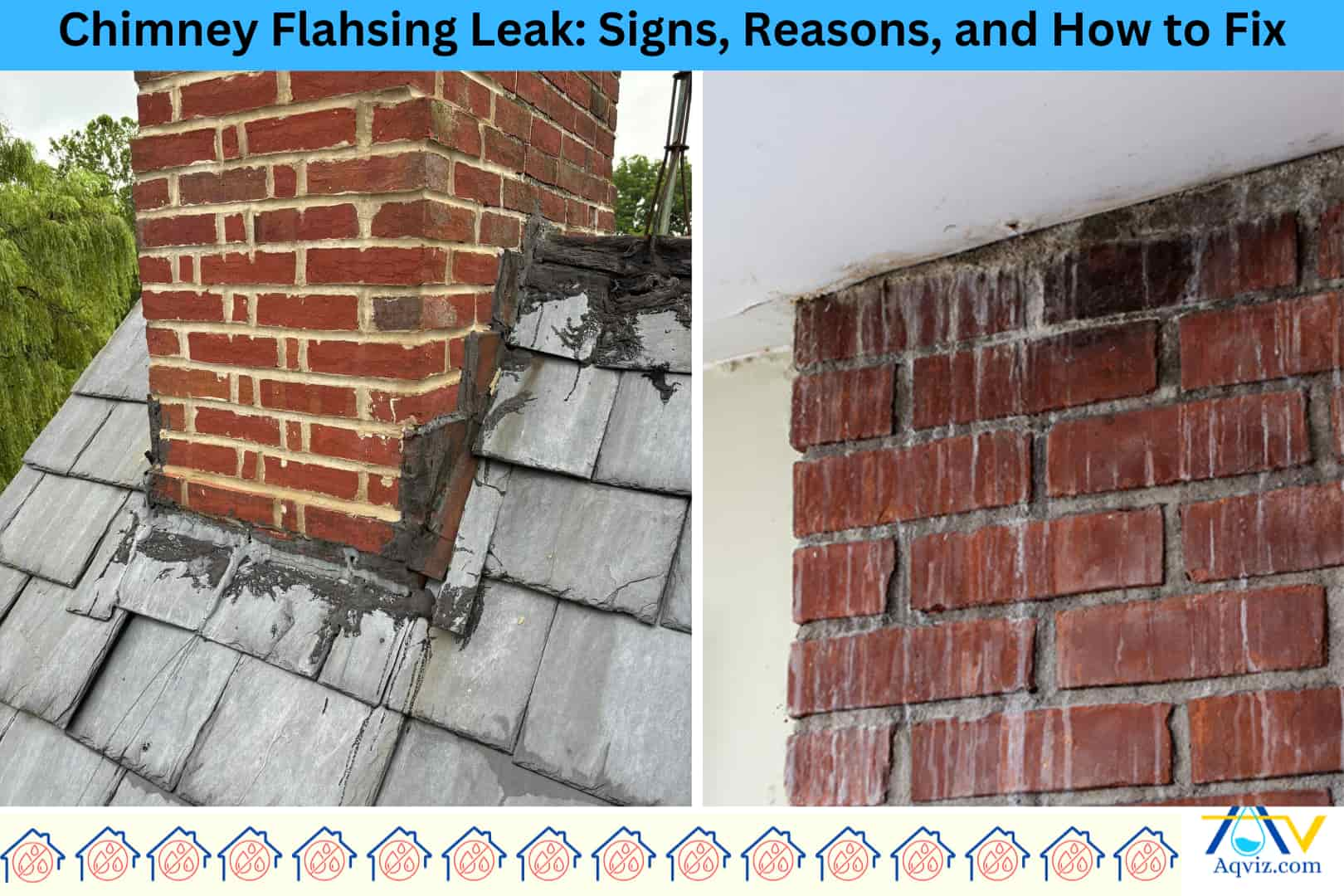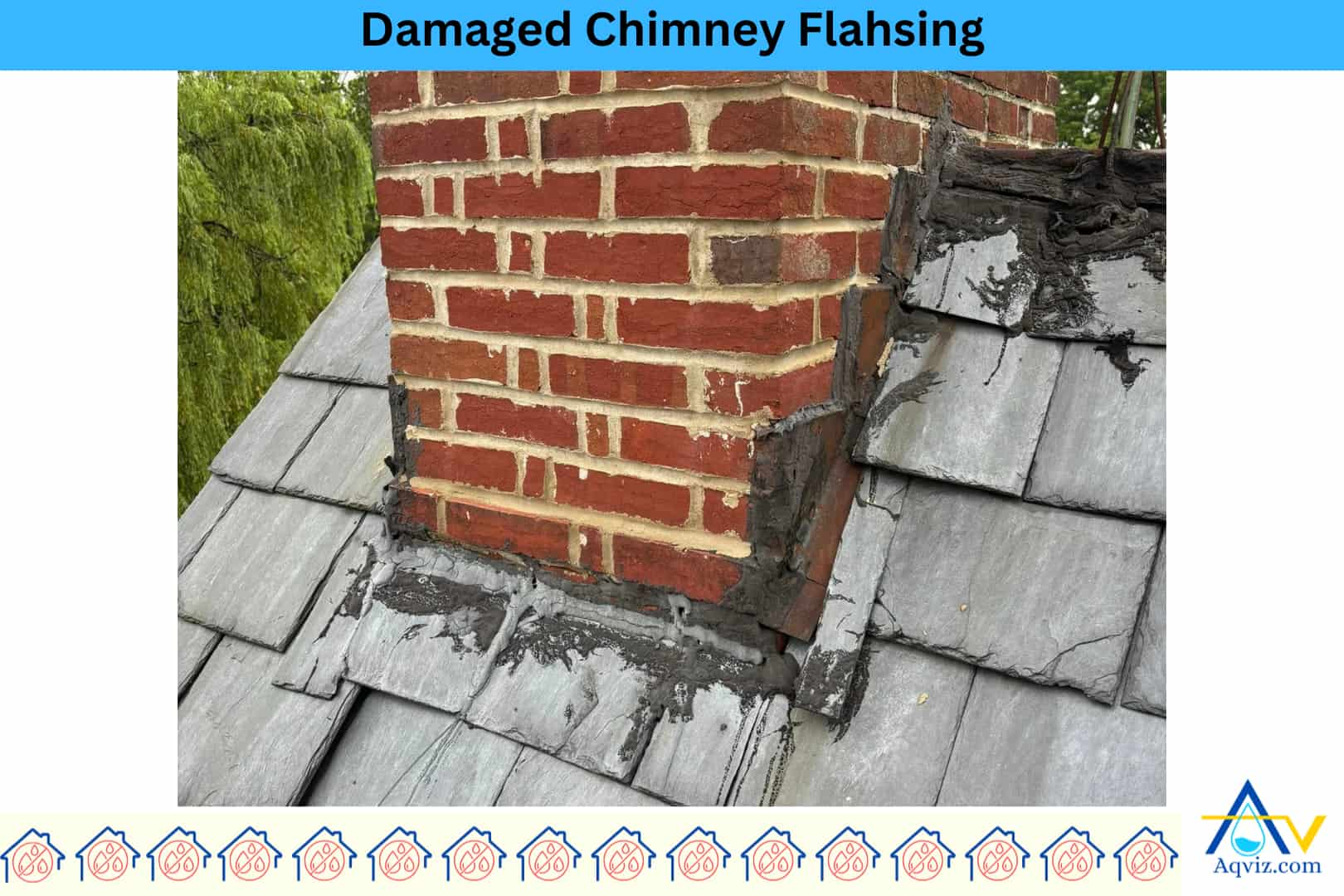Chimney flashing Leaks: Signs, Reasons, Impacts and How to Fix it

Chimney flashing is a thin metal sheet, usually made of aluminum, copper, or galvanized steel, designed to prevent rainwater from entering the roof. A chimney flashing leak is a water intrusion issue that happens when the metal flashing around a chimney no longer seals the joint between the roof and chimney structure.
Chimney flashing leaks occur due to aging materials, improper installation, mortar joint deterioration, roof settling or shifting, and sealing failure. You can detect chimney flashing by ceiling stains near the chimney, water dripping in the fireplace, damp attic insulation, visible gaps in flashing, and rust or corrosion on flashing. When a chimney flashing leaks, it tends to damage the ceiling and walls, roof decking, mold and mildew growth, fireplace deterioration, and insulation damage in the home.
So you should fix it DIY or use a professional handyman. Aqviz highly recommends you that you should fix this immediately to prevent water damage in the home structure. When you waterproof the roof properly, you should always pay special attention to this matter. More than that, Aqviz experts suggest that you should inspect flashing manually, seal mortar joints, install a chimney cricket, apply waterproof coating, keep the gutter and roof valley clean, and hire a certified roofer for flashing work to keep the flashing free of water damage in the home.
What Is a Chimney Flashing Leak?
A chimney flashing leak is a water intrusion issue that happens when the metal flashing around a chimney no longer seals the joint between the roof and chimney structure.
Chimney flashing is a thin metal sheet, usually made of aluminum, copper, or galvanized steel, designed to prevent rainwater from entering the roof.
Chimney flashing leaks occur at the chimney base where step flashing meets the roof shingles or where counter flashing is embedded into the brick mortar. These points are most likely to separate, rust, or crack.
Once compromised, flashing allows water to seep under shingles and into the attic, causing different water problems and damage to the structure.
Read More About: What to Know About Roof Waterproofing?

What Are the Reasons for a Chimney Flashing Leak?
There are 4 major reasons for chimney flashing leaks, including aging materials, improper installation, mortar joint deterioration, roof settling or shifting, and sealing failure.
- Improper installation : Improper installation leaves gaps between flashing sections or fails to overlap the components correctly.
- Mortar joint deterioration : Mortar joint deterioration allows counter flashing to loosen and pull away from the chimney wall.
- Roof settling or shifting : Roof settling or shifting causes movement at the chimney base. This movement pulls flashing loose or separates it from the shingles and chimney, creating leak paths.
- Sealing failure : Sealing failure happens when roofing tar, caulking, or silicone used around flashing dries out or cracks.
How to Detect a Chimney Flashing Leak?
Chimney flashing leaks can be detected by following these 5 ways. Detecting a chimney flashing leak early helps prevent major water damage inside the home.
- Ceiling stains near the chimney : Ceiling stains near the chimney often show yellow, brown, or dark spots on drywall. These marks indicate water is seeping through the roof near the flashing.
- Water dripping in the fireplace : Water dripping or pooling inside the fireplace after rain suggests water is entering through failed chimney flashing or missing sealant joints.
- Damp attic insulation : Damp attic insulation around the chimney base signals a slow leak at the flashing area.
- Visible gaps in flashing : Visible gaps or lifting in metal flashing around the chimney can be seen from the roof. Even small separations allow rain to penetrate under the shingles.
- Rust or corrosion on flashing : Rust or corrosion on metal flashing is a clear sign of long-term moisture exposure.
What Happens When Chimney Flashing Leaks?
When chimney flashing leaks, it allows rainwater to penetrate the roof structure and cause serious damage over time. So here are 5 negative impacts of a chimney flashing leak that we observed in our service life.
- Ceiling and wall damage : Leaking flashing leads to stained ceilings, bubbling paint, and damaged drywall near the chimney.
- Roof decking rot : When the moisture trapped under shingles near the chimney rots the plywood roof decking. This causes soft spots to develop and weaken the structural support and requiring costly repairs to the roof
- Mold and mildew growth : Water from a flashing leak creates the perfect condition for mold and mildew growth. Mold and mildew growth produce odor gases that can harm humans.
- Fireplace deterioration : Water entering the chimney structure can damage flue liners, rust damper assemblies, and deteriorate masonry inside the firebox.
- Insulation damage : Wet insulation around the chimney loses its thermal value and compresses. This reduces energy efficiency and raises heating and cooling costs.

How to Fix a Chimney Flashing Leak?
To fix a chimney flashing leak, you should follow the 5 steps below.
- Reseal flashing joints : Reseal flashing joints using roofing caulk or high-grade silicone to close small cracks and prevent water entry at seams and edges.
- Replace damaged step flashing : Replace damaged step flashing if metal pieces are rusted, bent, or missing. Step flashing must overlap shingles properly to guide water away.
- Install new counter flashing : Install new counter flashing when the existing one pulls away from the mortar joints. Fresh flashing should embed into the brick and cover the step flashing below.
- Tuckpoint chimney mortar : Tuckpoint chimney mortar by removing loose or cracked mortar around the flashing. Solid mortar anchors the counter flashing securely in place.
- Use a waterproof membrane: Use a waterproof membrane under flashing for extra leak protection. Peel-and-stick flashing tape helps seal joints between roofing layers and chimney bricks.
- Rebuild flashing system : Rebuild the flashing system entirely if it’s severely deteriorated. Full replacement includes step flashing, counter flashing, sealants, and proper shingle integration.
Read More About Other Water Problems on the Roof
How to Avoid Chimney Flashing Leak Problems?
To avoid chimney flashing leak problems, you should follow the following 6 methods.
- Inspect flashing annually : Inspect flashing annually for rust, cracks, or lifting metal. Early detection helps you fix small issues before they lead to major water intrusion.
- Seal mortar joints : Seal mortar joints around the chimney with waterproof masonry sealant. This prevents water from entering gaps where counter flashing is installed.
- Install a chimney cricket : Install a chimney cricket behind wide chimneys on sloped roofs. This small diversion ridge directs water around the chimney instead of pooling behind it.
- Apply waterproof roof coating : Apply waterproof roof coating around the chimney base and flashing area. Elastomeric coatings help seal small gaps and protect vulnerable transitions.
- Keep gutters and roof valleys clean : Keep gutters and roof valleys clean to prevent water buildup around the chimney. Overflow and pooling can push water under the flashing.
- Hire a certified roofer for flashing work : Hire a certified roofer to install or repair flashing. Proper flashing work requires precision, and poor installation is one of the leading causes of chimney leaks.
